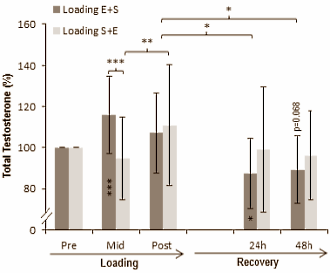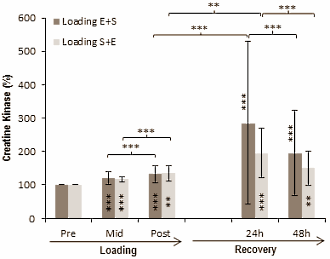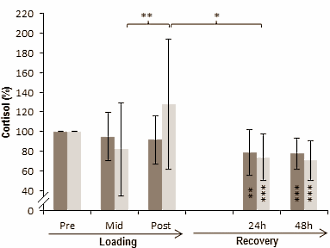The purpose of this study was to investigate acute neuromuscular and endocrine responses and recovery to a single session of combined endurance and strength loading using 2 loading orders. Forty-two men were demographically matched to perform a single session of combined endurance + strength (E + S) or strength + endurance (S + E) loading. The strength loading was conducted on a leg press and included sets of power, maximal strength, and hypertrophic loads with an overall duration of 30 minutes. The endurance loading was conducted on a bike ergometer and performed by continuous cycling over 30 minutes at 65% of subject's individual maximal watts. Both loading conditions led to significant acute reductions in maximal force production (E + S: -27%, p < 0.001; S + E: -22%, p < 0.001), rapid force produced in 500 milliseconds (E + S: -26%, p < 0.001; S + E: -18%, p < 0.001), and countermovement jump height (E + S: -15%, p < 0.001; S + E: -12%, p < 0.001), whereas no significant differences between the 2 loadings were observed. Maximal and explosive force production recovered after 48 hours after both loading conditions. Whereas no significant acute responses were found in concentrations of serum testosterone (T) and thyroid-stimulating hormone in the 2 loading conditions, concentrations of T were significantly reduced in E + S during recovery at 24 hours (-13%, p < 0.05) and 48 hours (-11%, p = 0.068), but not in S + E, and concentrations of thyroid-stimulating hormone significantly reduced after both loading conditions (24 hours: E + S, -32%, p < 0.001; S + E, -25%, p < 0.01; 48 hours: E + S, -25%, p < 0.001; S + E, -18%, p < 0.01). The loading conditions in this study showed that neuromuscular performance recovered already within 2 days, whereas endocrine function, observed particularly by decreased concentrations in serum T after the E + S loading order, remained altered still after 48 hours of recovery. These results emphasize the different needs for recovery after 2 loading orders.


